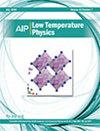New emission band of solid nitrogen
IF 0.8
4区 物理与天体物理
Q4 PHYSICS, APPLIED
引用次数: 0
Abstract
New results on the study of radiation effects in solid nitrogen and N2-doped Ne matrix are presented, with a focus on the so-called γ-line origin. The irradiation was carried out in dc regime with an electron beam of subthreshold energy. The relaxation dynamics was monitored by emission spectroscopy: cathodoluminescence (CL) and nonstationary luminescence (NsL), along with current activation spectroscopy. Thermally stimulated luminescence (TSL) and exoelectron emission (TSEE) of pure nitrogen and N2 in the Ne matrix were measured in a correlated manner. Three emission bands were recorded in the NIR CL spectra of solid N2: 794, 802, and 810 nm. The band at 810 nm was detected for the first time. These three bands are characterized by similar behavior and form molecular series with spacing between adjacent vibrational energy levels of the ground state of 125 and 123 cm−1. These data cast doubt on the recently made assumption that the γ-line is attributed to the emission of the nitrogen anion N− [R. E. Boltnev, I. B. Bykhalo, I. N. Krushinskaya et al. Phys. Chem. Chem. Phys. 18, 16013 (2016)]. The processes of electron attachment and neutralization of positively charged species are discussed. It has been established that the γ-line in the TSL spectra of pure nitrogen and N2-doped Ne matrix correlates with TSEE currents and recombination emission of O+, N2+, and N4+ ions, which indicates its connection with the neutralization reaction. The measurement of NsL supported this conclusion. A new possible assignment of the γ-line and its satellites to the emission of tetranitrogen N4 is discussed.固态氮的新发射波段
本文介绍了固体氮和掺杂 N2 的 Ne 基体中辐射效应研究的新成果,重点是所谓的 γ 线起源。辐照是在直流状态下用阈下能量的电子束进行的。通过发射光谱监测弛豫动态:阴极发光(CL)和非稳态发光(NsL)以及电流活化光谱。以相关方式测量了纯氮和 Ne 基质中 N2 的热激发发光 (TSL) 和外电子发射 (TSEE)。在固体 N2 的近红外 CL 光谱中记录到三个发射带:794、802 和 810 纳米。810 纳米波段是首次检测到。这三个波段具有相似的行为特征,并形成分子系列,基态相邻振动能级之间的间隔为 125 和 123 cm-1。这些数据使人们对最近提出的关于 γ 线是氮阴离子 N- 发射的假设产生了怀疑 [R. E. Boltnev, I. R. Boltnev, I. R. Boltnev, I. R. Boltnev, I. R. R.E. Boltnev, I. B. Bykhalo, I. N. Krushinskaya et al.Chem.18, 16013 (2016)]。讨论了正电荷物种的电子附着和中和过程。研究发现,纯氮和掺杂 N2 的 Ne 基质 TSL 光谱中的γ 线与 O+、N2+ 和 N4+ 离子的 TSEE 电流和重组发射相关,这表明它与中和反应有关。对 NsL 的测量也支持这一结论。讨论了 γ 线及其卫星线对四氮 N4 发射的新的可能归属。
本文章由计算机程序翻译,如有差异,请以英文原文为准。
求助全文
约1分钟内获得全文
求助全文
来源期刊

Low Temperature Physics
物理-物理:应用
CiteScore
1.20
自引率
25.00%
发文量
138
审稿时长
3 months
期刊介绍:
Guided by an international editorial board, Low Temperature Physics (LTP) communicates the results of important experimental and theoretical studies conducted at low temperatures. LTP offers key work in such areas as superconductivity, magnetism, lattice dynamics, quantum liquids and crystals, cryocrystals, low-dimensional and disordered systems, electronic properties of normal metals and alloys, and critical phenomena. The journal publishes original articles on new experimental and theoretical results as well as review articles, brief communications, memoirs, and biographies.
Low Temperature Physics, a translation of the copyrighted Journal FIZIKA NIZKIKH TEMPERATUR, is a monthly journal containing English reports of current research in the field of the low temperature physics. The translation began with the 1975 issues. One volume is published annually beginning with the January issues.
 求助内容:
求助内容: 应助结果提醒方式:
应助结果提醒方式:


